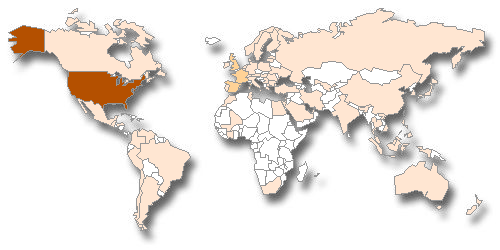 A very dangerous Trojan kits are continuing to wreak havoc on a massive, global scale, according to malware researchers. The family includes different variants of the Trojan.Vundo threat. Symantec researchers have reported that this virus has a wide variety of “features” which it may use to ensure almost complete control of the computers which it infects. The replication of this Trojan is low, but all that it takes is the good obfuscator and a spam campaign to get it going. It may cause a lot of damage to infected systems, and this is why users affected by it are strongly advised to remove it from their computers if they believe it is running on them. Read this article thoroughly to see the symptoms of Trojan.Vundo and learn how to delete it from your computer system.
A very dangerous Trojan kits are continuing to wreak havoc on a massive, global scale, according to malware researchers. The family includes different variants of the Trojan.Vundo threat. Symantec researchers have reported that this virus has a wide variety of “features” which it may use to ensure almost complete control of the computers which it infects. The replication of this Trojan is low, but all that it takes is the good obfuscator and a spam campaign to get it going. It may cause a lot of damage to infected systems, and this is why users affected by it are strongly advised to remove it from their computers if they believe it is running on them. Read this article thoroughly to see the symptoms of Trojan.Vundo and learn how to delete it from your computer system.

Threat Summary
| Name |
Trojan.Vundo also known as Trojan.Vundo.I
|
| Type | Trojan Kit |
| Short Description | Trojan.Vundo gives the cyber-crook behind it complete access to the infected computer. |
| Symptoms | The user may witness pop-up messages and heavy advertising displayed by Trojan.Vundo if they are infected. |
| Distribution Method | Via an Exploit kit and spam e-mail. Malicious JavaScript Injection. |
| Detection Tool |
See If Your System Has Been Affected by malware
Download
Malware Removal Tool
|
| User Experience | Join our forum to Discuss Trojan.Vundo. |

Trojan.Vundo – How It Spreads
This malware may use your typical methods to spread. One of those methods is by sending obfuscated executables to its victims. These executables may be of different types and may resemble legitimate Microsoft Office documents, Adobe Reader documents, pictures or other legitimate files. They may be sent out via various spam bots and other spamming software as e-mail attachments. However, there are also other possibilities by which these malicious files may be spread:
- Via social media spam from fake or copycat Facebook accounts.
- Via another type of spam in chat services like Skype, etc.
- Through different ad-supported programs that may cause a browser redirect to a malicious URL which might cause a drive-by-download type of infection.
Trojan.Vundo is a very dangerous threat, and how dangerous it can be to you depends on what specifically you have on your computer and what are you using it for. This is why we strongly advise checking for this and other malware by scanning your computer with an advanced anti-malware program immediately since this program may run concealed.

Trojan.Vundo – More Information
In addition to the information above, the Trojan.Vundo malware family is also very widespread. Symantec researchers report that it causes approximately 1500 to 2000 infections per day on a global scale. Here is the distribution of the Vundo Trojans on the world map:
The main goal of the Vundo Trojan once it infects your system is to begin and display ads on your computer. The advertisements may be of any character, from adult advertisements, to completely legitimate and harmless ones. Some of the advertisements may even contain other malware, like ransomware, for example. Some of the ads may ever redirect to online scams, such as Tech Support scams and others.
Symantec researchers have also reported that this Trojan.Vundo may also inject malicious JavaScript into legitimate search engines used on the infected computers. It may affect the following search engines:
- AltaVista
- AOL Search
- Ask
- Bing
- FastSearch
- Hotbot
- Live
- Lycos
- Yahoo
In addition to those damages and the fact that Trojan.Vundo may monitor all of the activity on the web browser including what passwords you type and what other information you input, like financial data, etc. Trojans from this family may also perform the following unauthorized activities:
- Disable Task Manager.
- Disable Windows Registry Editor.
- Disable Microsoft System Configuration.
- Stop Safe Mode into running and stop its settings.
- Disable any protection, like Windows Defender.
- Block updates.

Trojan.Vundo Malware – Complete Removal Instructions
Since deleting Trojans from the Trojan.Vundo family may turn out to be difficult, we urge you to attempt removing it by using an advanced anti-malware program. However, bear in mind that the Trojan may be remotely controlled and programmed to disable any security software from running. This is why it is advisable that you to follow the instructions from this article to remove your hard drive that has been infected by this malware and insert in on a safe system on which you can use the instructions below and scan the drive after which automatically remove the Trojan.Vundo installed on it. We also strongly advise having an advanced anti-malware installed on the computer to scan the drive. To have best results, it is also advisable to follow the programmed instructions below.
Preparation before removing Trojan.Vundo.
Before starting the actual removal process, we recommend that you do the following preparation steps.
- Make sure you have these instructions always open and in front of your eyes.
- Do a backup of all of your files, even if they could be damaged. You should back up your data with a cloud backup solution and insure your files against any type of loss, even from the most severe threats.
- Be patient as this could take a while.
- Scan for Malware
- Fix Registries
- Remove Virus Files
Step 1: Scan for Trojan.Vundo with SpyHunter Anti-Malware Tool



Step 2: Clean any registries, created by Trojan.Vundo on your computer.
The usually targeted registries of Windows machines are the following:
- HKEY_LOCAL_MACHINE\Software\Microsoft\Windows\CurrentVersion\Run
- HKEY_CURRENT_USER\Software\Microsoft\Windows\CurrentVersion\Run
- HKEY_LOCAL_MACHINE\Software\Microsoft\Windows\CurrentVersion\RunOnce
- HKEY_CURRENT_USER\Software\Microsoft\Windows\CurrentVersion\RunOnce
You can access them by opening the Windows registry editor and deleting any values, created by Trojan.Vundo there. This can happen by following the steps underneath:


 Tip: To find a virus-created value, you can right-click on it and click "Modify" to see which file it is set to run. If this is the virus file location, remove the value.
Tip: To find a virus-created value, you can right-click on it and click "Modify" to see which file it is set to run. If this is the virus file location, remove the value.Step 3: Find virus files created by Trojan.Vundo on your PC.
1.For Windows 8, 8.1 and 10.
For Newer Windows Operating Systems
1: On your keyboard press + R and write explorer.exe in the Run text box and then click on the Ok button.

2: Click on your PC from the quick access bar. This is usually an icon with a monitor and its name is either “My Computer”, “My PC” or “This PC” or whatever you have named it.

3: Navigate to the search box in the top-right of your PC's screen and type “fileextension:” and after which type the file extension. If you are looking for malicious executables, an example may be "fileextension:exe". After doing that, leave a space and type the file name you believe the malware has created. Here is how it may appear if your file has been found:

N.B. We recommend to wait for the green loading bar in the navigation box to fill up in case the PC is looking for the file and hasn't found it yet.
2.For Windows XP, Vista, and 7.
For Older Windows Operating Systems
In older Windows OS's the conventional approach should be the effective one:
1: Click on the Start Menu icon (usually on your bottom-left) and then choose the Search preference.

2: After the search window appears, choose More Advanced Options from the search assistant box. Another way is by clicking on All Files and Folders.

3: After that type the name of the file you are looking for and click on the Search button. This might take some time after which results will appear. If you have found the malicious file, you may copy or open its location by right-clicking on it.
Now you should be able to discover any file on Windows as long as it is on your hard drive and is not concealed via special software.
Trojan.Vundo FAQ
What Does Trojan.Vundo Trojan Do?
The Trojan.Vundo Trojan is a malicious computer program designed to disrupt, damage, or gain unauthorized access to a computer system. It can be used to steal sensitive data, gain control over a system, or launch other malicious activities.
Can Trojans Steal Passwords?
Yes, Trojans, like Trojan.Vundo, can steal passwords. These malicious programs are designed to gain access to a user's computer, spy on victims and steal sensitive information such as banking details and passwords.
Can Trojan.Vundo Trojan Hide Itself?
Yes, it can. A Trojan can use various techniques to mask itself, including rootkits, encryption, and obfuscation, to hide from security scanners and evade detection.
Can a Trojan be Removed by Factory Reset?
Yes, a Trojan can be removed by factory resetting your device. This is because it will restore the device to its original state, eliminating any malicious software that may have been installed. Bear in mind that there are more sophisticated Trojans that leave backdoors and reinfect even after a factory reset.
Can Trojan.Vundo Trojan Infect WiFi?
Yes, it is possible for a Trojan to infect WiFi networks. When a user connects to the infected network, the Trojan can spread to other connected devices and can access sensitive information on the network.
Can Trojans Be Deleted?
Yes, Trojans can be deleted. This is typically done by running a powerful anti-virus or anti-malware program that is designed to detect and remove malicious files. In some cases, manual deletion of the Trojan may also be necessary.
Can Trojans Steal Files?
Yes, Trojans can steal files if they are installed on a computer. This is done by allowing the malware author or user to gain access to the computer and then steal the files stored on it.
Which Anti-Malware Can Remove Trojans?
Anti-malware programs such as SpyHunter are capable of scanning for and removing Trojans from your computer. It is important to keep your anti-malware up to date and regularly scan your system for any malicious software.
Can Trojans Infect USB?
Yes, Trojans can infect USB devices. USB Trojans typically spread through malicious files downloaded from the internet or shared via email, allowing the hacker to gain access to a user's confidential data.
About the Trojan.Vundo Research
The content we publish on SensorsTechForum.com, this Trojan.Vundo how-to removal guide included, is the outcome of extensive research, hard work and our team’s devotion to help you remove the specific trojan problem.
How did we conduct the research on Trojan.Vundo?
Please note that our research is based on an independent investigation. We are in contact with independent security researchers, thanks to which we receive daily updates on the latest malware definitions, including the various types of trojans (backdoor, downloader, infostealer, ransom, etc.)
Furthermore, the research behind the Trojan.Vundo threat is backed with VirusTotal.
To better understand the threat posed by trojans, please refer to the following articles which provide knowledgeable details.



